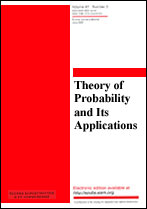|
This article is cited in 60 scientific papers (total in 60 papers)
Stopping Brownian motion without anticipation as close as possible to its ultimate maximum
S. E. Graversena, G. Peskira, A. N. Shiryaevb
a Institute of Mathematics, University of Aarhus, Denmark
b Steklov Mathematical Institute, Russian Academy of Sciences
Abstract:
Let $B=(B_t)_{0 \le t \le 1}$ be the standard Brownian motion started at 0, and let $S_t=\max_{ 0 \le r \le t} B_r$ for $0 \le t \le 1$. Consider the optimal stopping problem
$$ V_*=\inf_\tau{\mathsf E}(B_\tau-S_1)^2, $$
where the infimum is taken over all stopping times of $B$ satisfying $0 \le \tau \le 1$. We show that the infimum is attained at the stopping time $\tau_*=\inf\{0\le t\le 1\mid S_t-B_t\ge z_*\sqrt{1-t}\}$, where $z_*=1.12 \ldots$ is a unique root of the equation $4\Phi(z_*)-2z_*\varphi(z_*)-3=0$ with $\varphi(x)=(1/\sqrt{2 \pi })\,e^{-x^2/2}$ and $ \Phi (x)=\int_{-\infty}^x \varphi(y) dy$. The value $V_*$ equals $2 \Phi (z_*)-1$. The method of proof relies upon a stochastic integral representation of $S_1$, time-change arguments, and the solution of a free-boundary (Stefan) problem.
Keywords:
Brownian motion, optimal stopping, anticipation, ultimate maximum, free-boundary (Stefan) problem, Ito–Clark representation theorem, Markov process, diffusion.
Received: 21.10.1999
Citation:
S. E. Graversen, G. Peskir, A. N. Shiryaev, “Stopping Brownian motion without anticipation as close as possible to its ultimate maximum”, Teor. Veroyatnost. i Primenen., 45:1 (2000), 125–136; Theory Probab. Appl., 45:1 (2001), 41–50
Linking options:
https://www.mathnet.ru/eng/tvp327https://doi.org/10.4213/tvp327 https://www.mathnet.ru/eng/tvp/v45/i1/p125
|


|




 Contact us:
Contact us: Terms of Use
Terms of Use
 Registration to the website
Registration to the website Logotypes
Logotypes








 Citation in format
Citation in format 
